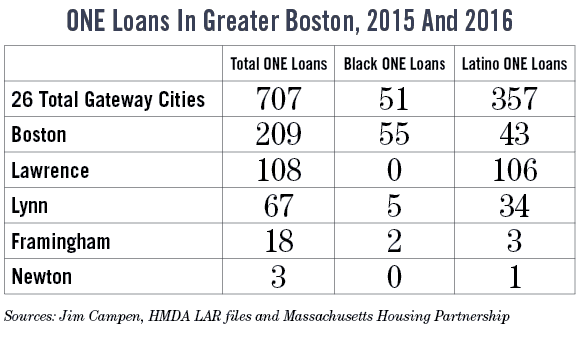ONE mortgages have done an outstanding job of helping black and Latino borrowers in Massachusetts purchase their first home, but it is also becoming less effective as area home values rise, according to recently released Data from the Massachusetts Housing Partnership of Home Mortgage Disclosure Act data.
Available to first-time homebuyers who earn 100 percent or less of the area median income, the ONE mortgage can be used to purchase condominiums, single-, two- and three-family homes. The loans, originated by 42 banks and credit unions and backed by a loan loss reserve held by MHP, abide by Fannie Mae mortgage limits – $453,100 for a single-family house.
Borrowers who qualify for a condo or single-family home need at least a 3 percent down payment, creating a high loan-to-value ratio that a financial institution would likely never agree to without mortgage insurance. MHP’s loan loss reserve fills this void, and saves first-time homebuyers hundreds of dollars per month. The loan also comes with a generously discounted 30-year fixed interest rate.
“It’s the most affordable and best program in the state for people who qualify,” said Jim Campen, a retired professor who analyzes HMDA loan data and creates an annual report for the Massachusetts Community & Banking Council called “Changing Patterns.” “I think it’s interesting that in Boston, the ONE program has done a particularly good job of reaching black borrowers.”
According to the new ONE loan data in Massachusetts, black borrowers received 9.3 percent of the 1,653 loans issued in 2015 and 2016. Latino borrowers received 29 percent of all ONE loans issued.
In Boston, black borrowers received 29.3 percent of the 209 ONE loans issued, whereas Latino borrowers received 20.6 percent.
“This is the first year we were able to get Jim our own data and show that the ONE product is reaching borrowers in ways that other products aren’t,” said Elliot Schmiedl, director of homeownership at MHP.
In addition to doing a good job of distributing ONE mortgages to communities of color, the program also has a history of good credit throughout its 25-year existence.
According to Schmiedl, the delinquency rate in the current ONE Mortgage portfolio as of Sept. 30 was just below 4 percent. The default rate was .75 percent. These numbers compare very well to prime loans in Massachusetts that traditionally have higher credit scores and larger down payments, he said.
Gateway Cities Vs. Boston
 While the program has had great success overall, over the last two years it has done better with Latino borrowers, a trend that Campen and Schmiedl attribute to geography – those borrowers have tended to live in more affordable parts of the state, such as the Gateway Cities.
While the program has had great success overall, over the last two years it has done better with Latino borrowers, a trend that Campen and Schmiedl attribute to geography – those borrowers have tended to live in more affordable parts of the state, such as the Gateway Cities.
According to the data for 2015 and 2016, 707 ONE loans were issued in Gateway Cities – more than 100 went to Lawrence residents and 67 went to Lynn residents.
In Boston during those years, 209 ONE loans were issued (111 in 2015 and 98 in 2016).
In nine other cities in the state with more than 50,000 residents, many of which are in the Greater Boston area such as Newton, Cambridge, Waltham and Brookline, only 92 ONE loans were issued – 17 in Cambridge, five each in Brookline and Waltham, and just three in Newton.
“The state is very segregated. Latino buyers are finding that communities like Lynn and Lawrence are still affordable,” said Schmiedl, adding that even those areas are starting to attract investors. “Traditionally, black borrowers have used the program to buy their first home in Boston, but for most people Boston is out of reach. A lot of black borrowers who used to buy in Boston are now buying in Randolph, Stoughton and Brockton.”
Hyde Park and Mattapan are the only neighborhoods in Boston where market-rate properties are still attainable for buyers using the ONE program, Schmiedl said. Although some ONE loans are still issued in Roxbury, Chinatown and Dorchester, they’re mostly subsidized units with an affordable resale restriction, he said.
According to data from The Warren Group, publisher of Banker & Tradesman, Hyde Park had a median single-family home price of just under $400,000 year-to-date through October, while Mattapan had a median single-family home price of $365,000.
Neighborhoods like East Boston have become difficult for ONE loans. The median single-family home price rose this year to $430,000.
Gateway Cities that have seen success with ONE loans, such as Lawrence, Brockton and Lowell, all had a median single-family home price at $270,000 or below, according to The Warren Group.
Room For Improvement
Affordability is one of the main limiting factors to ONE loans, said Tom Callahan, executive director of the Massachusetts Affordable Housing Alliance.
“A lot of buyers can’t buy in Boston or the immediate suburbs. Different buyers make different decisions,” he said, adding that he thinks Boston’s recent passage of the Community Preservation Act may help the situation. “Some people choose to stay as renters because they want to buy in Boston. … It’s kind of depressing. Some borrowers who qualify just can’t afford current home prices.”
The high demand for housing has worsened the situation, said Schmiedl; even if eligible borrowers have the 3 percent down, and can afford a $400,000 or $500,000 property, there’s a lot of competition from borrowers with a higher down payment.
“The numbers paint a stark picture that households of color, particularly black borrowers, are still left behind when it comes to borrowing,” said Schmiedl. “Homeownership rates of blacks and Latinos are still far behind white borrowers, and that exacerbates the wealth gap because a house is your most valuable asset.”








